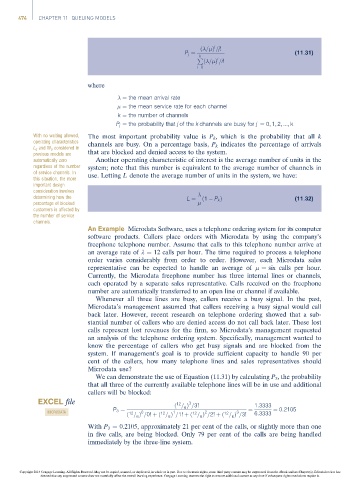Page 494 -
P. 494
474 CHAPTER 11 QUEUING MODELS
j
ð = Þ =j!
P j ¼ (11:31)
k
P i
ð = Þ =i!
i¼0
where
¼ the mean arrival rate
¼ the mean service rate for each channel
k ¼ the number of channels
P j ¼ the probability that j of the k channels are busy for j ¼ 0; 1; 2; :::; k
With no waiting allowed, The most important probability value is P k , which is the probability that all k
operating characteristics channels are busy. On a percentage basis, P k indicates the percentage of arrivals
L q and W q considered in
previous models are that are blocked and denied access to the system.
automatically zero Another operating characteristic of interest is the average number of units in the
regardless of the number system; note that this number is equivalent to the average number of channels in
of service channels. In use. Letting L denote the average number of units in the system, we have:
this situation, the more
important design
consideration involves
determining how the L ¼ ð1 P k Þ (11:32)
percentage of blocked
customers is affected by
the number of service
channels.
An Example Microdata Software, uses a telephone ordering system for its computer
software products. Callers place orders with Microdata by using the company’s
freephone telephone number. Assume that calls to this telephone number arrive at
an average rate of l ¼ 12 calls per hour. The time required to process a telephone
order varies considerably from order to order. However, each Microdata sales
representative can be expected to handle an average of ¼ six calls per hour.
Currently, the Microdata freephone number has three internal lines or channels,
each operated by a separate sales representative. Calls received on the freephone
number are automatically transferred to an open line or channel if available.
Whenever all three lines are busy, callers receive a busy signal. In the past,
Microdata’s management assumed that callers receiving a busy signal would call
back later. However, recent research on telephone ordering showed that a sub-
stantial number of callers who are denied access do not call back later. These lost
calls represent lost revenues for the firm, so Microdata’s management requested
an analysis of the telephone ordering system. Specifically, management wanted to
know the percentage of callers who get busy signals and are blocked from the
system. If management’s goal is to provide sufficient capacity to handle 90 per
cent of the callers, how many telephone lines and sales representatives should
Microdata use?
We can demonstrate the use of Equation (11.31) by calculating P 3 , the probability
that all three of the currently available telephone lines will be in use and additional
callers will be blocked:
EXCEL file ð = Þ =3! 1:3333
3
12
P 3 ¼ 6 ¼ ¼ 0:2105
MICRODATA 12 0 12 1 12 2 12 3 6:3333
ð = Þ =0! þð = Þ =1! þð = Þ =2! þð = Þ =3!
6
6
6
6
With P 3 ¼ 0.2105, approximately 21 per cent of the calls, or slightly more than one
in five calls, are being blocked. Only 79 per cent of the calls are being handled
immediately by the three-line system.
Copyright 2014 Cengage Learning. All Rights Reserved. May not be copied, scanned, or duplicated, in whole or in part. Due to electronic rights, some third party content may be suppressed from the eBook and/or eChapter(s). Editorial review has
deemed that any suppressed content does not materially affect the overall learning experience. Cengage Learning reserves the right to remove additional content at any time if subsequent rights restrictions require it.

